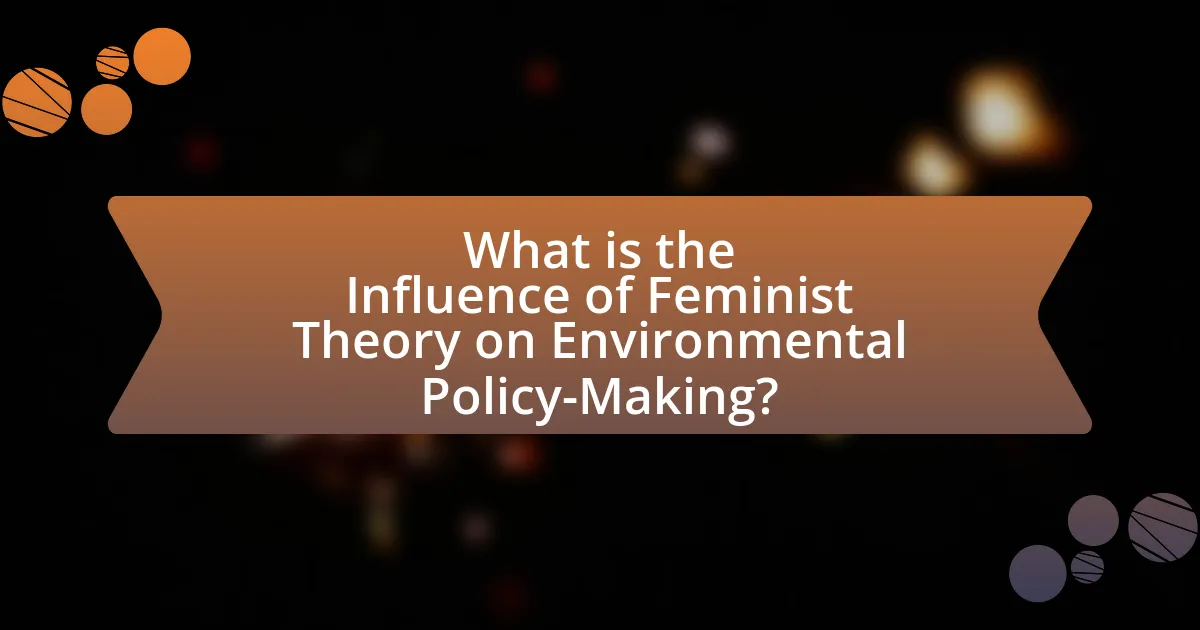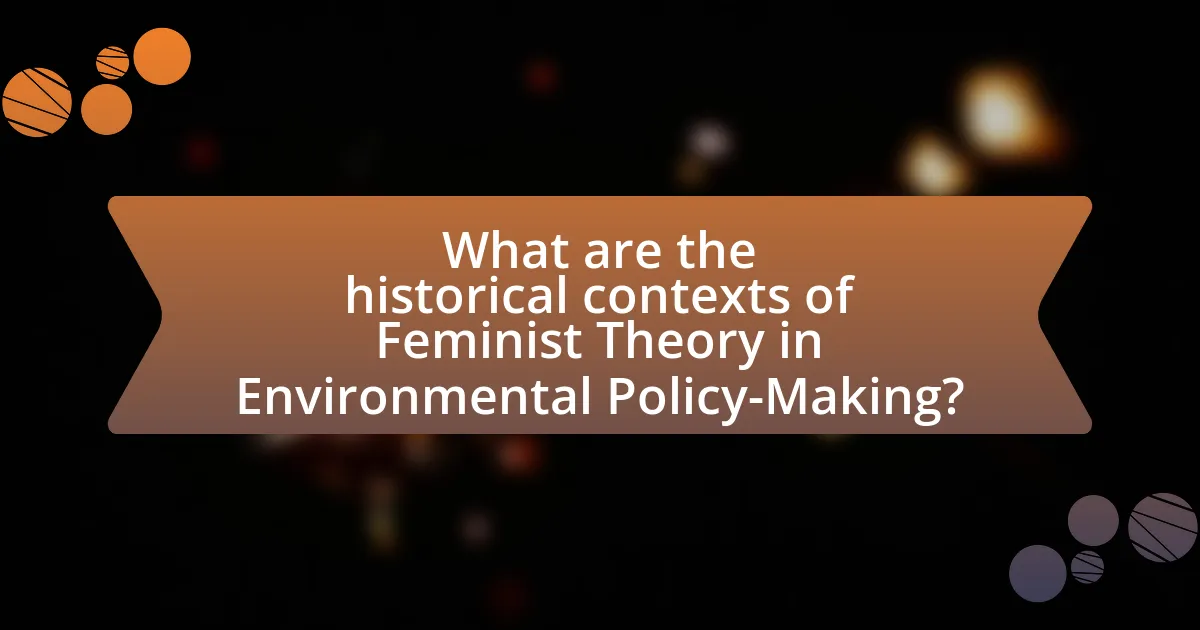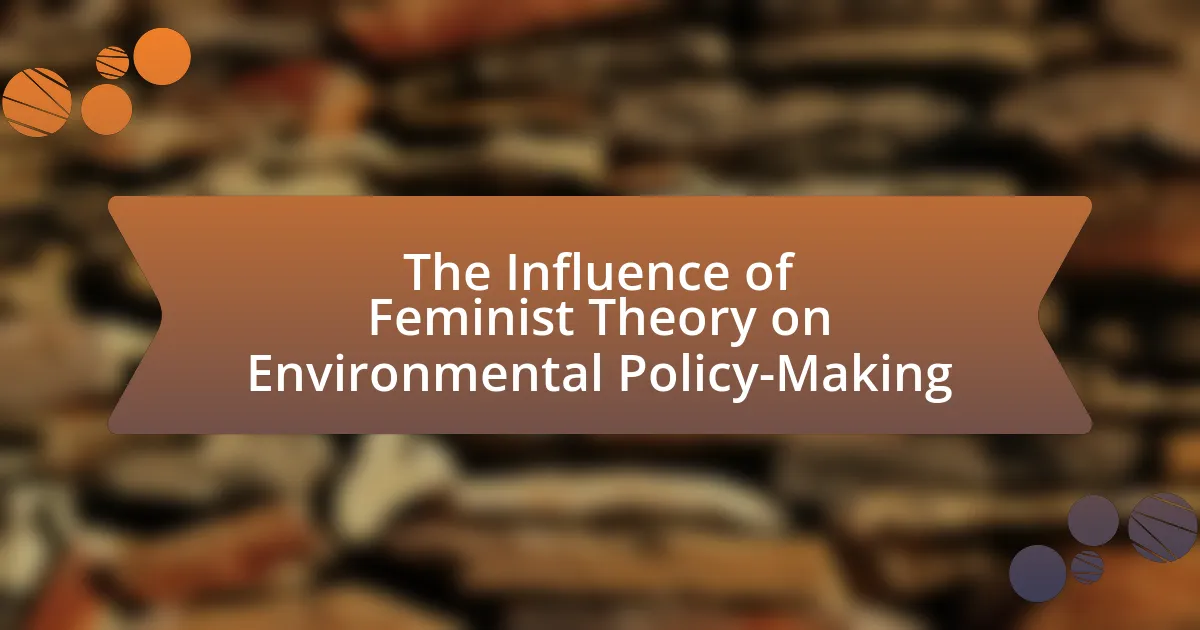The article examines the significant influence of Feminist Theory on environmental policy-making, highlighting the interconnectedness of gender, environment, and social justice. It discusses how traditional environmental policies often overlook the unique experiences and contributions of women, particularly in developing countries, where they are disproportionately affected by environmental degradation and climate change. Key principles of Feminist Theory relevant to environmental issues are outlined, including the importance of gender equity and inclusive decision-making processes. The article also addresses the historical context of Feminist Theory in environmental advocacy, critiques of its application, and practical strategies for integrating feminist perspectives into environmental policies to promote more equitable and sustainable outcomes.

What is the Influence of Feminist Theory on Environmental Policy-Making?
Feminist theory significantly influences environmental policy-making by emphasizing the interconnectedness of gender, environment, and social justice. This perspective highlights how environmental degradation disproportionately affects women, particularly in developing countries, where they often bear the brunt of resource scarcity and climate change impacts. Research indicates that integrating feminist principles into environmental policies can lead to more equitable and sustainable outcomes, as seen in initiatives that prioritize women’s participation in decision-making processes. For example, studies show that countries with higher female representation in environmental governance tend to adopt more comprehensive climate policies, reflecting the importance of diverse perspectives in addressing complex environmental issues.
How does Feminist Theory intersect with Environmental Policy-Making?
Feminist Theory intersects with Environmental Policy-Making by emphasizing the importance of gender equity in environmental governance and recognizing the disproportionate impact of environmental issues on women. This intersection highlights how traditional environmental policies often overlook women’s roles and contributions, leading to ineffective solutions. For instance, research shows that women are more vulnerable to climate change effects due to their social and economic positions, as evidenced by the United Nations’ findings that women make up 70% of the world’s poor, who are most affected by environmental degradation. By integrating feminist perspectives, policymakers can create more inclusive and effective environmental strategies that address both gender and ecological concerns.
What are the key principles of Feminist Theory relevant to environmental issues?
The key principles of Feminist Theory relevant to environmental issues include the recognition of the interconnectedness of gender and environmental degradation, the critique of patriarchal structures that contribute to ecological harm, and the advocacy for inclusive decision-making processes that consider women’s experiences and knowledge. Feminist Theory emphasizes that environmental issues disproportionately affect women, particularly in marginalized communities, due to existing social inequalities. This perspective is supported by research indicating that women are often the primary managers of natural resources in many societies, yet they face systemic barriers in environmental governance. By integrating gender analysis into environmental policy-making, Feminist Theory aims to create more equitable and sustainable solutions that address both ecological and social justice.
How does Feminist Theory challenge traditional environmental policies?
Feminist Theory challenges traditional environmental policies by highlighting the intersectionality of gender and environmental issues, arguing that these policies often overlook the unique experiences and needs of women. Traditional environmental policies typically prioritize economic growth and technological solutions, which can perpetuate gender inequalities and ignore the roles women play in resource management and conservation. For instance, women are often the primary caregivers and managers of natural resources in many communities, yet their contributions are frequently marginalized in policy discussions. This perspective is supported by research indicating that inclusive policies that consider gender dynamics lead to more effective environmental outcomes, as seen in various case studies where women’s involvement improved sustainability practices.
Why is it important to integrate Feminist Theory into Environmental Policy-Making?
Integrating Feminist Theory into Environmental Policy-Making is crucial because it addresses the intersectionality of gender and environmental issues, ensuring that policies are equitable and inclusive. Feminist Theory highlights how women and marginalized groups often bear the brunt of environmental degradation and climate change, as evidenced by studies showing that women in developing countries are disproportionately affected by resource scarcity and environmental disasters. By incorporating feminist perspectives, policymakers can create strategies that not only mitigate environmental harm but also empower these vulnerable populations, leading to more effective and sustainable outcomes.
What are the potential benefits of a feminist approach to environmental issues?
A feminist approach to environmental issues can enhance social equity and promote sustainable practices. By integrating gender perspectives, this approach addresses the disproportionate impact of environmental degradation on women, particularly in developing regions where they often bear the brunt of resource scarcity. Research indicates that women are key stakeholders in natural resource management, and their involvement leads to more effective environmental governance. For instance, a study by the United Nations Development Programme found that when women participate in decision-making processes, environmental outcomes improve, as they bring unique knowledge and experiences related to resource use and conservation. This inclusive strategy not only fosters resilience in communities but also contributes to broader environmental sustainability goals.
How can Feminist Theory contribute to more equitable environmental policies?
Feminist Theory can contribute to more equitable environmental policies by emphasizing the interconnectedness of social justice and environmental sustainability. This theoretical framework highlights how marginalized groups, particularly women, are disproportionately affected by environmental degradation and climate change, advocating for their inclusion in policy-making processes. Research shows that women often play crucial roles in resource management and conservation, yet they remain underrepresented in decision-making positions. For instance, a study by the United Nations Development Programme found that when women are involved in environmental governance, policies are more likely to address the needs of vulnerable populations and lead to sustainable outcomes. By integrating feminist perspectives, environmental policies can become more inclusive, addressing systemic inequalities and promoting equitable resource distribution.

What are the historical contexts of Feminist Theory in Environmental Policy-Making?
Feminist Theory in Environmental Policy-Making has historical contexts rooted in the intersection of gender, ecology, and social justice movements. In the 1970s, early feminist scholars began to critique traditional environmental policies for their gender-blindness, highlighting how environmental degradation disproportionately affects women, particularly in developing countries. This critique was further developed in the 1980s and 1990s, as scholars like Vandana Shiva emphasized the connection between patriarchy and ecological exploitation, arguing that women’s roles in resource management are often overlooked in policy discussions. The 1992 United Nations Conference on Environment and Development in Rio de Janeiro marked a significant moment, as it recognized the importance of gender in sustainable development, leading to the incorporation of feminist perspectives in environmental frameworks. These historical contexts illustrate how Feminist Theory has evolved to challenge and reshape environmental policy-making by advocating for inclusive approaches that consider the unique experiences and contributions of women.
How has Feminist Theory evolved in relation to environmental movements?
Feminist Theory has evolved to integrate environmental concerns by emphasizing the interconnectedness of gender, ecology, and social justice. Initially, feminist perspectives focused primarily on issues of gender inequality, but over time, they began to recognize how environmental degradation disproportionately affects women, particularly in developing countries. This shift is evident in the work of scholars like Vandana Shiva, who argues that women’s roles in agriculture and resource management are crucial for sustainable practices. Furthermore, the emergence of ecofeminism in the 1970s highlighted the parallels between the exploitation of women and nature, advocating for a holistic approach to environmental activism that includes feminist principles. This evolution has led to increased advocacy for policies that address both gender and environmental issues, such as the United Nations’ Sustainable Development Goals, which explicitly link gender equality and environmental sustainability.
What key events have shaped the integration of Feminist Theory in environmental advocacy?
Key events that have shaped the integration of Feminist Theory in environmental advocacy include the 1991 publication of “Ecofeminism: Linking Ecology and Feminism” by Greta Gaard and the 1992 United Nations Conference on Environment and Development, which highlighted the intersection of gender and environmental issues. The emergence of ecofeminism as a distinct movement in the late 20th century emphasized the connection between the exploitation of women and nature, advocating for a holistic approach to environmental justice. Additionally, the 2002 World Summit on Sustainable Development further solidified the role of gender in environmental policy, leading to increased recognition of women’s contributions to sustainable practices. These events collectively underscored the necessity of incorporating feminist perspectives into environmental advocacy, influencing policy-making and activism globally.
How have feminist scholars influenced environmental policy development over time?
Feminist scholars have significantly influenced environmental policy development by integrating gender perspectives into environmental issues, thereby highlighting the interconnectedness of social justice and ecological sustainability. This influence is evident in the emergence of ecofeminism, which critiques traditional environmental policies for neglecting the roles and experiences of women, particularly in resource management and climate change impacts. For instance, the 1992 United Nations Conference on Environment and Development in Rio de Janeiro incorporated gender considerations into its agenda, largely due to advocacy from feminist scholars and activists. Additionally, feminist scholars have contributed to the development of frameworks that emphasize participatory governance, ensuring that women’s voices are included in decision-making processes related to environmental policies. This shift has led to more equitable and effective environmental strategies that recognize the diverse impacts of environmental degradation on different genders.
What are the major critiques of Feminist Theory in Environmental Policy-Making?
Major critiques of Feminist Theory in Environmental Policy-Making include its perceived lack of intersectionality, the tendency to prioritize gender over other social categories, and the insufficient engagement with local ecological knowledge. Critics argue that Feminist Theory often fails to adequately address how race, class, and other identities intersect with gender, leading to a one-dimensional approach to environmental issues. For instance, scholars like Vandana Shiva emphasize the importance of integrating indigenous and local women’s knowledge into environmental policies, which is often overlooked in mainstream feminist discourse. Additionally, some argue that Feminist Theory can inadvertently reinforce existing power structures by focusing primarily on women’s roles without challenging broader systemic inequalities.
What limitations exist within Feminist Theory when applied to environmental issues?
Feminist Theory faces several limitations when applied to environmental issues, primarily due to its focus on gender inequality rather than ecological concerns. This narrow focus can lead to the neglect of intersectional factors such as race, class, and environmental justice, which are crucial for a comprehensive understanding of environmental problems. For instance, while feminist perspectives highlight women’s roles in environmental stewardship, they may overlook how systemic inequalities affect both men and women differently in various cultural contexts. Additionally, Feminist Theory often emphasizes social constructs over the material realities of environmental degradation, which can limit its effectiveness in addressing urgent ecological crises. This limitation is evident in the lack of integration between feminist environmentalism and broader ecological movements, which can hinder collaborative efforts for sustainable policy-making.
How do critics argue against the effectiveness of Feminist Theory in policy-making?
Critics argue that Feminist Theory is ineffective in policy-making due to its perceived lack of practical applicability and its tendency to prioritize gender issues over other critical factors. They contend that policies influenced by Feminist Theory often fail to address broader socio-economic and environmental contexts, which can lead to oversimplified solutions that do not account for the complexities of real-world issues. For instance, some critics highlight that while Feminist Theory emphasizes the importance of gender equity, it may overlook the intersectionality of race, class, and environmental justice, resulting in policies that do not adequately serve all affected communities. This critique is supported by studies indicating that policies developed solely through a feminist lens can inadvertently marginalize other important perspectives, thereby limiting their overall effectiveness in achieving comprehensive and sustainable outcomes in environmental policy-making.

What are the practical applications of Feminist Theory in Environmental Policy-Making?
Feminist Theory has practical applications in environmental policy-making by emphasizing the intersectionality of gender and environmental issues, which leads to more inclusive and equitable policies. For instance, integrating women’s perspectives in resource management can enhance sustainability, as evidenced by studies showing that women often play crucial roles in agriculture and water management, leading to better environmental outcomes. Additionally, feminist approaches advocate for the recognition of marginalized voices, ensuring that policies address the needs of diverse communities affected by environmental degradation. This is supported by research indicating that inclusive policy-making processes result in more effective environmental governance and resilience strategies.
How can policymakers implement Feminist Theory in environmental strategies?
Policymakers can implement Feminist Theory in environmental strategies by integrating gender analysis into environmental decision-making processes. This approach ensures that the unique experiences and needs of women, particularly in marginalized communities, are considered in environmental policies. For instance, research shows that women are often disproportionately affected by environmental degradation, as they are typically responsible for managing natural resources in their households. By incorporating gender-responsive frameworks, such as the Gender and Environment Initiative by the United Nations Environment Programme, policymakers can create more equitable and effective environmental strategies that address both ecological and social justice.
What specific policies have successfully integrated feminist perspectives?
Specific policies that have successfully integrated feminist perspectives include the Gender and Climate Change Action Plan implemented by the United Nations Framework Convention on Climate Change (UNFCCC). This plan emphasizes the importance of gender equality in climate action, recognizing that women are disproportionately affected by climate change and play a crucial role in environmental management. Additionally, the Gender Equality and Women’s Empowerment Policy of the European Union promotes gender-responsive approaches in environmental policies, ensuring women’s participation in decision-making processes related to sustainability. These policies are backed by research indicating that gender-inclusive strategies lead to more effective environmental outcomes, as highlighted in the 2018 report by the Global Gender and Climate Alliance, which demonstrates that women’s involvement in climate initiatives enhances community resilience and adaptive capacity.
How can community engagement reflect feminist principles in environmental initiatives?
Community engagement can reflect feminist principles in environmental initiatives by prioritizing inclusivity, collaboration, and the empowerment of marginalized voices. Feminist theory emphasizes the importance of diverse perspectives, particularly those of women and other underrepresented groups, in decision-making processes. For instance, initiatives that actively involve women in environmental planning and management have been shown to lead to more sustainable outcomes, as evidenced by the UN’s recognition of women’s roles in natural resource management. Furthermore, community engagement fosters a sense of ownership and responsibility among participants, aligning with feminist values of shared power and collective action. This approach not only enhances the effectiveness of environmental initiatives but also promotes social equity, demonstrating the interconnectedness of gender and environmental issues.
What are the challenges faced when applying Feminist Theory to Environmental Policy-Making?
The challenges faced when applying Feminist Theory to Environmental Policy-Making include the intersectionality of gender with environmental issues, the marginalization of women’s voices in policy discussions, and the difficulty in integrating feminist perspectives into traditionally male-dominated environmental frameworks. Intersectionality complicates the analysis of how various social identities, such as race and class, influence environmental experiences and policies. Marginalization occurs as women’s contributions and needs are often overlooked in decision-making processes, leading to policies that do not adequately address gender-specific environmental impacts. Additionally, integrating feminist perspectives requires a shift in the dominant paradigms of environmental policy, which can be met with resistance from established institutions that prioritize economic growth over social equity.
What obstacles do advocates encounter in promoting feminist environmental policies?
Advocates encounter several obstacles in promoting feminist environmental policies, primarily including institutional resistance, lack of funding, and societal misconceptions. Institutional resistance manifests in the form of entrenched power structures that prioritize traditional environmental policies over feminist perspectives, often sidelining gender considerations in decision-making processes. Lack of funding limits the ability of feminist organizations to effectively advocate for their policies, as financial resources are often allocated to more mainstream environmental initiatives. Societal misconceptions about feminism and environmentalism can also hinder advocacy efforts, as some individuals perceive feminist environmental policies as radical or unnecessary, which can lead to public pushback and reduced support for initiatives that integrate gender equity into environmental strategies.
How can these challenges be addressed to enhance policy effectiveness?
To enhance policy effectiveness in the context of feminist theory’s influence on environmental policy-making, integrating diverse stakeholder perspectives is essential. This can be achieved by actively involving women and marginalized communities in the decision-making process, ensuring their voices and experiences shape policy outcomes. Research indicates that policies developed with inclusive participation are more likely to address the specific needs of these groups, leading to more equitable and effective environmental solutions. For instance, a study by the United Nations Environment Programme highlights that gender-responsive policies improve resource management and community resilience, demonstrating the tangible benefits of inclusive approaches.
What best practices can be adopted for integrating Feminist Theory into Environmental Policy-Making?
Integrating Feminist Theory into Environmental Policy-Making can be effectively achieved through several best practices. First, policymakers should ensure inclusive stakeholder engagement, prioritizing the voices of women and marginalized communities who are often disproportionately affected by environmental issues. Research indicates that women’s participation in environmental decision-making leads to more equitable and sustainable outcomes, as seen in various case studies globally.
Second, adopting an intersectional approach is crucial, recognizing how gender intersects with other social categories such as race, class, and ethnicity. This approach allows for a more nuanced understanding of environmental challenges and the development of tailored solutions. For instance, the United Nations Environment Programme emphasizes the importance of intersectionality in addressing climate change impacts on different demographic groups.
Third, integrating gender analysis into environmental assessments can help identify specific vulnerabilities and contributions of women in environmental contexts. This practice is supported by the Gender and Environment Resource Center, which highlights that gender-responsive policies enhance the effectiveness of environmental initiatives.
Lastly, training and capacity-building for policymakers on gender and environmental issues can foster a deeper understanding of Feminist Theory’s relevance in this field. Evidence from various training programs shows that enhanced knowledge leads to more informed policy decisions that consider gender dynamics.
By implementing these best practices, environmental policy-making can become more equitable and effective, aligning with the principles of Feminist Theory.
What strategies can organizations use to promote feminist perspectives in environmental advocacy?
Organizations can promote feminist perspectives in environmental advocacy by integrating gender analysis into environmental policies and practices. This involves assessing how environmental issues disproportionately affect women and marginalized groups, thereby ensuring that their voices and experiences are included in decision-making processes. For instance, the United Nations Environment Programme emphasizes the importance of gender-responsive approaches in environmental governance, highlighting that women’s participation leads to more effective and equitable outcomes. Additionally, organizations can collaborate with feminist groups to develop educational campaigns that raise awareness about the intersectionality of gender and environmental issues, fostering a more inclusive dialogue. By implementing these strategies, organizations can effectively advocate for policies that reflect feminist values and address the unique challenges faced by women in environmental contexts.
How can collaboration between feminist and environmental groups be fostered?
Collaboration between feminist and environmental groups can be fostered through the establishment of shared goals that address both gender equality and environmental sustainability. By recognizing the interconnectedness of social justice and ecological issues, these groups can create joint initiatives that highlight how environmental degradation disproportionately affects women, particularly in marginalized communities. For instance, research indicates that women are often the primary caregivers and resource managers in many societies, making them key stakeholders in environmental conservation efforts. Collaborative projects, such as community-based resource management programs, can empower women while promoting sustainable practices. Additionally, organizing joint workshops and conferences can facilitate knowledge exchange and strengthen alliances, ultimately leading to more effective advocacy for policies that reflect both feminist and environmental priorities.
